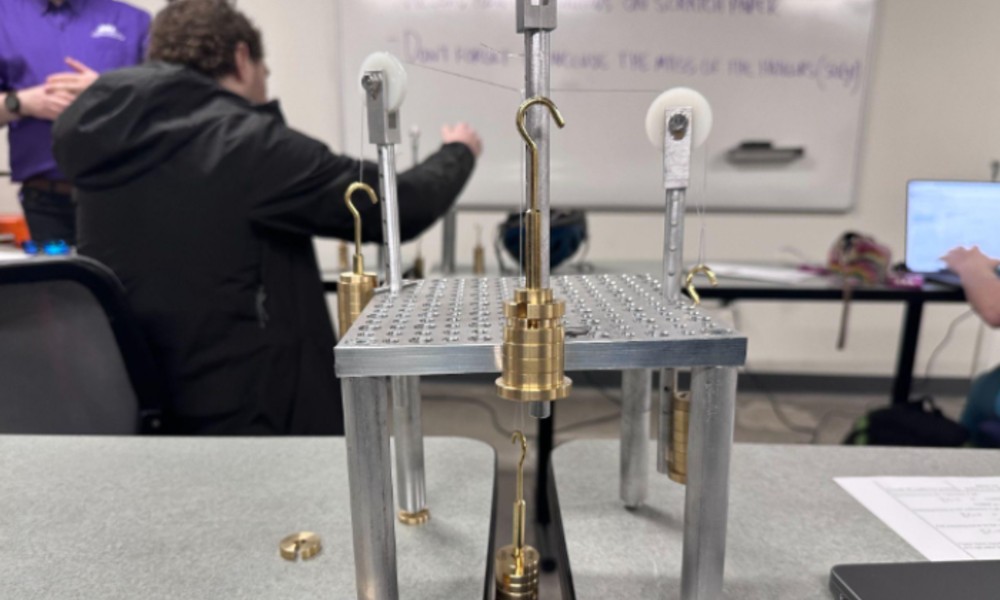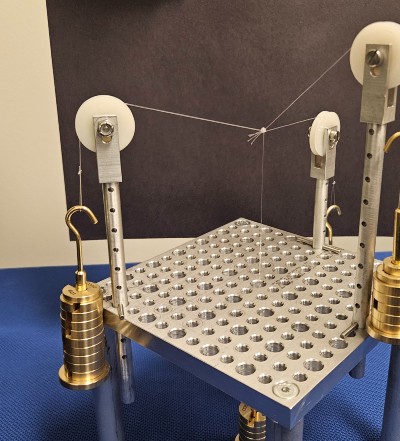Force equilibrium: A new way to learn a classic engineering concept
News
For years, through textbooks and equations, JMU Engineering students have learned about force equilibrium—the principle that when all forces acting on an object cancel out, it remains stable.
|
Think of a water bottle sitting on a table. Gravity pulls it down, but the table pushes it back up with equal force, keeping it still—that’s equilibrium. If you design a bridge or a building, you don’t want it to shift or collapse, you want the forces to balance so it stays standing." — Dr. Steven Woodruff |
However, for Engineering professor Steven Woodruff, textbooks and calculations weren’t enough. Students needed to see equilibrium in action. To bring the concept to life, he developed a hands-on lab for his Statistics and Introductory Mechanics class.
Last summer, Woodruff attended a Kern Entrepreneurial Engineering (KEEN) workshop for engineering educators, where he was introduced to a 3D Particle Equilibrium Model, a small-scale experiment illustrating force balance. Seeing its potential as a teaching tool, he adapted the concept for engineering students. Instead of using the original 3D-printed design, he chose aluminum for greater durability and cost-effectiveness.
With the help of JMU’s Engineering shop team, Woodruff designed and built 15 models from scratch. The process involved precision drilling and carefully tying fishing wires, which took from November to late January to complete. "Tying all 15 models was a challenge, but now students can engage with a real-world system instead of just visualizing one," Woodruff said.
The 3D Particle Equilibrium Model is a tabletop experiment designed to help students understand how forces balance. The model consists of a sturdy aluminum table with holes drilled half an inch apart, resembling graph paper. Metal rods and pulleys guide thin fishing wires, each connected to adjustable weights. At the center, the wires meet at a knot—the equilibrium point—where all forces must balance to keep the system stable.
Students work in pairs, adjusting weights and calculating forces acting on the knot. The system shifts if the forces aren’t perfectly balanced, providing immediate visual and physical feedback. "It’s like a game of tug-of-war," Woodruff said. "If one side pulls too hard, the balance is lost. When students can see the forces at play, the math makes more sense."
 A key feature of the model is its adaptability. By moving the rods, Woodruff can change the force distribution, creating new problem-solving challenges for students. "I could move these bars to any of these holes, and it would fundamentally change what weights they need to apply to it," he said.
A key feature of the model is its adaptability. By moving the rods, Woodruff can change the force distribution, creating new problem-solving challenges for students. "I could move these bars to any of these holes, and it would fundamentally change what weights they need to apply to it," he said.
Before this lab, students solved force equilibrium problems on paper but often struggled to connect their calculations to real-world applications. Now, instead of just solving equations, they can see the direct impact of force distribution through hands-on experimentation. "Engineering isn’t just about numbers on a page," Woodruff said. "Every structure we design—from bridges to buildings—has to work in the real world. I wanted students to experience that firsthand."
Statistics and Introductory Mechanics is one of the first engineering courses students take at JMU. It provides the groundwork for advanced structural design and mechanics courses. "At the start of their education, students sometimes feel like they’re just doing busywork," Woodruff said. "But this lab shows them that our teaching has real applications. They'll appreciate this foundation when designing a bridge or a crane."
By the end of the course, students will have solved equations and developed an intuition for equilibrium—an essential skill in engineering. "Experienced engineers can look at a design and instantly tell if something is off," Woodruff said. "I want students to start building that intuition before they enter the field."
Woodruff’s hands-on approach helps students think like real engineers, applying knowledge that extends beyond the textbook. Students are building the problem-solving skills students will need in their careers, whether they’re designing skyscrapers, transportation systems, or mechanical structures.
"This is just the beginning," Woodruff said. "The more we can take engineering off the page and into real life, the better prepared our students will be."
